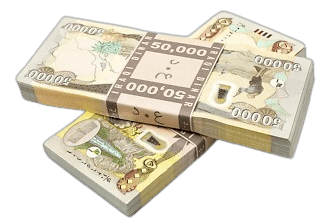Iraqi Dinar Guide: History, Key Facts & 2025 Developments
Let’s separate facts from hype. This guide walks through the dinar’s historical context, the policy signals leaders are making in 2025, and what realistic timelines look like.
🏛 Melbourne-based • AUSTRAC registered • 14+ years of currency expertise

The Historical Context: What Actually Happened
Understanding where the dinar came from helps explain where it might go. Before 1990, Iraq’s economy and institutions supported a much stronger official exchange rate.
The Pre-1990 Reality
- • 1980s official peg: 1 IQD = $3.22 USD
- • Middle-income economy with modern banking
- • Significant oil industry and infrastructure
- • Active international trade relationships
This reflected real economic fundamentals: large oil reserves, functioning institutions, and modern infrastructure for its era.
What Changed (1990–2011)
- • 1990–91 Gulf War: sanctions, damaged infrastructure, severed banking links
- • 1990s sanctions era: Oil‑for‑Food limits, black‑market divergence
- • 2003–2011: new currency issued, large devaluation, gradual stabilization
The Current Reality (2025)
Roughly 500 IQD ≈ 1 USD reflects today’s output, international confidence, reconstruction costs, and regional security considerations.
Official Statements from Iraqi Leaders (2023–2025)
CBI Governor Ali Al‑Allaq: Digital Currency Vision
- • 26 Feb 2025: CBI developing a central bank digital currency (CBDC)
- • Cash use to decline as digital payments expand
- • Objective: maintain price stability & support sustainable development
Prime Minister Mohammed Shia Al‑Sudani
- • Commitment not to repeat past devaluations
- • Government and CBI to work to strengthen dinar versus USD
- • Feb 2023: cabinet approved revaluation to 1,300 IQD per USD
Policy Coordination & Market Reforms
- • PM advisor: rate changes based on CBI recommendations
- • Deputy Governor: legacy dollar auction system phased out (end‑2024)
- • CBI initiatives: SME financing (One Trillion), large projects (Five Trillion), renewable energy support
- • Reported results: non‑oil GDP growth and sectoral expansion
Historical Currency Policy (2023)
- • Official rate set at 1,300 IQD per USD (from 1,460)
- • Rationale included tightening US dollar flows and price stability aims
What They’re Committing To
- • Develop a CBDC and modernize payments
- • Systematic strengthening of the dinar over time
- • Economic diversification away from oil
- • Integration with international standards
What They’re Not Promising
- • Specific timelines or targets
- • Guaranteed returns or sudden revaluations
Understanding Currency Revaluations
What a Revaluation Requires
- • Stronger fundamentals: productivity, reserves, fiscal position
- • Institutional capacity: stable government & central bank
- • Modern financial infrastructure & banking links
Real‑World Patterns
- • Germany (1948): DM launch with rebuilding & external support
- • South Korea (1960s–80s): export‑led modernization
- • China (2005–15): gradual appreciation with huge reserves
Currency strength follows economic strength—not the other way around.
Iraq’s Economic Foundation (2024–2025)
Energy Resources
- • ~145B barrels proven (top‑5 globally); additional probable 45B+
- • ~4.4M bpd avg production (2024); #2 in OPEC
- • Export capacity 3.8M+ bpd; expanded refining since 2020
Financial Position
- • $100B+ FX reserves (end‑2024); ~130+ tons of gold
- • External debt reduced; budgets passed on time
- • Oil ≈ 85–90% of revenue; ~$100B+ at $70/bbl
Demographics & Diversification
- • 45M+ population; young, urbanizing
- • Manufacturing, agriculture, construction recovering
- • Services sector expanding in major cities
Major Investments & Modernization (2024–2025)
Energy & Power Projects
- • TotalEnergies: multi‑billion GGIP; 1,000MW solar; gas flaring reduction
- • BP: redevelopment in Kirkuk region; production uplift plans
- • ACWA Power & QatarEnergy: large‑scale solar partnerships
Finance & Infrastructure
- • IFC: sustainable finance roadmap; sector investments
- • Development Road, airport & port upgrades, highways, grid modernization
- • National Investment Commission: strong FDI inflows reported
CBDC & Redenomination
- • CBDC R&D launched; payments & cross‑border systems upgrading
- • Redenomination discussed (e.g., 50,000 → 50 IQD; same purchasing power)
- • Redenomination ≠ revaluation; mainly convenience & psychology
Banking Modernization
- • Rafidain restructuring; SWIFT integration; electronic payments
- • Credit cards, mobile & online banking rollout; SME lending programs
Economic Indicators & Regional Integration
Key Indicators (late‑2024)
- • Inflation ≈ 2.7%; food prices stabilized
- • Oil exports ≈ $8B+ monthly; current account generally positive
- • Exchange rate relatively stable; low black‑market premium
Regional & International Links
- • Stronger ties with US, Turkey, Jordan, GCC; active with IMF, World Bank, OPEC, UN
- • Trade corridors and energy grid connections expanding
Realistic Timelines
Short‑term (1–2 years)
- • Banking modernization completion
- • Digital payments rollout & CBDC pilots
- • Infrastructure project delivery
Medium‑term (3–5 years)
- • Non‑oil growth & credit rating improvements
- • Deeper regional integration
- • Confidence building with consistent policy
Long‑term (5+ years)
- • Diversified economy; modern financial system
- • Currency convertibility & broader international use
Why Choose DinarExchange (Australia)
Local Compliance & Expertise
- • AUSTRAC registered; Australian Consumer Law protections
- • 14+ years tracking dinar developments
- • Authentication, storage guidance, and post‑revaluation support
Support & Education
- • Regular updates on verified developments
- • Educational resources; verification services
- • No predictions, no guarantees, no hype
Getting Started: Pricing & Process
Transparent Pricing
- • ≈ $2,800 AUD per 1,000,000 IQD (illustrative)
- • Reflects market rates plus reasonable margins
- • Express delivery included Australia‑wide
Authentication & Storage
- • Verified authentic notes; certificates available
- • Guidance on safe, long‑term storage
What You Need to Know
- • Legal to own foreign currency in Australia
- • Tax depends on personal circumstances—consult a professional
- • Speculative & high‑risk: only use funds you can afford to lose
- • Timelines unknown and possibly very long
Contact Australia’s Currency Specialists
We’ve served Australians for 14+ years with facts, not hype. Get current pricing, educational resources, authentication services, and post‑revaluation guidance.
